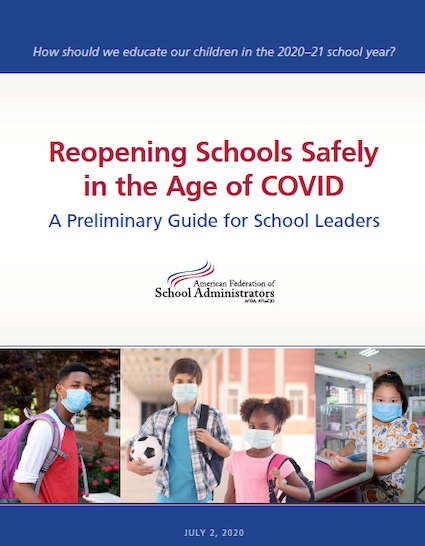School supervisory personnel who were among the first to call for closing schools at the start of the pandemic today issued a new, comprehensive guide for reopening schools safely.
“School leaders want to reopen their schools, on time and in person,” said Ernest Logan, president of the American Federation of School Administrators (AFSA), which represents principals, assistant principals, supervisors, and school directors and managers. “In a time of social and emotional upheaval, our students have never needed us more.”
Focused on “providing the best education possible based on the safest environment that can be created for our students, parents, educational staff and communities at large,” the AFSA guide, “Reopening Schools Safely in the Age of COVID,” covers the major challenges schools must address in the era of COVID-19. These issues range from sanitizing schools, handwashing, physical distancing and health screening to managing lunchrooms and transportation, redesigning academic programs and facilities, and training staff.
The guide recognizes that the precise practices used to open will vary from school to school, but it says all schools now confront three indisputable facts:
- The safety of students, school district employees and the community must be paramount.
- Parents must play a prominent role in determining what a school day looks like and remain engaged in the implementation process.
- A safe reopening will cost a great deal of money.
“This is not going to be easy,” said Logan, noting that estimates on the additional funding needed range from at least $158 billion to $244 billion. “But for the good of our children, it is not a should do, it is a must do.
“This guide is critical because AFSA members, principals, assistant principals, managers of school bus transportation, food service and student services, just to name a few, are the people on the ground in communities responsible to manage schools and implement any needed safety protocols,” he said. “This guide was designed to help them ask the right questions and engage the community.”
AFSA said communities should have realistic expectations about the process of reopening. “No matter how many safety protocols are put in place, there is no way to create a perfect environment,” the guide noted.
“Children and adults will get sick. Schools will need to be shut down and it will impact education. However, big investments in the right protocols and solid planning can minimize this likelihood and its consequences.”
“To be fully engaged in learning, students require face-to-face interaction with their teachers,” said Logan. “For us, distance learning serves an important purpose, but it does not equal in-person learning. It is insufficient to the demands of mind and heart. There is no place like school to ensure our students’ academic, social and emotional progress.”
“Executing a plan requiring that children wear masks and practice rigorous physical distancing may prove the most daunting of the challenges posed by reopening,” the guide notes. In addition, “reducing the risk of exposure to COVID-19 through cleaning and disinfection is a crucial aspect of reopening schools that requires careful planning.”
“As school leaders, we know how complex it is to create and manage a successful school and academic environment in the best of times,” the guide states. “As the people who will be charged with implementing the goals and aspirations of communities moving forward, we promise to be transparent in the process.”
AFSA outlines 17 ways to create a safe school environment. They include:
- Developing school-based safety strategies
- Sanitizing extensively
- Ensuring clean hands and physical distancing
- Screening for symptoms
- Reducing class size for physical distancing
- Planning for intermittent quarantine
- Establishing split schedules
- Staggering mealtimes
- Reconsidering transportation
- Addressing individually students with diverse needs
- Creating isolation spaces
- Communicating evidence of contact or cases to the community
- Modifying health care assignments within schools
- Monitoring school facilities constantly
- Providing broad-based training and support for all school personnel
- Addressing the impact of this pandemic on mental health needs
- Redesigning after-school programs
The guide was developed by a national task force of front-line administrative and supervisory experts, and will be distributed to AFSA’s more than 20,000 members and made available to all states and school districts. It can be found here.

